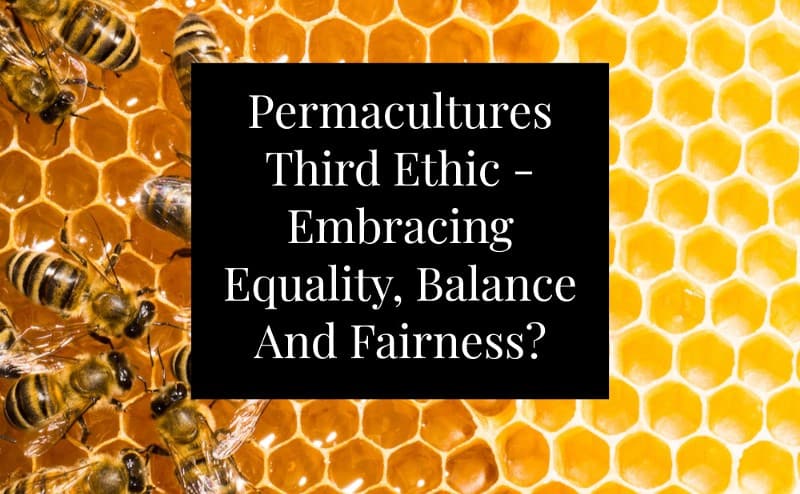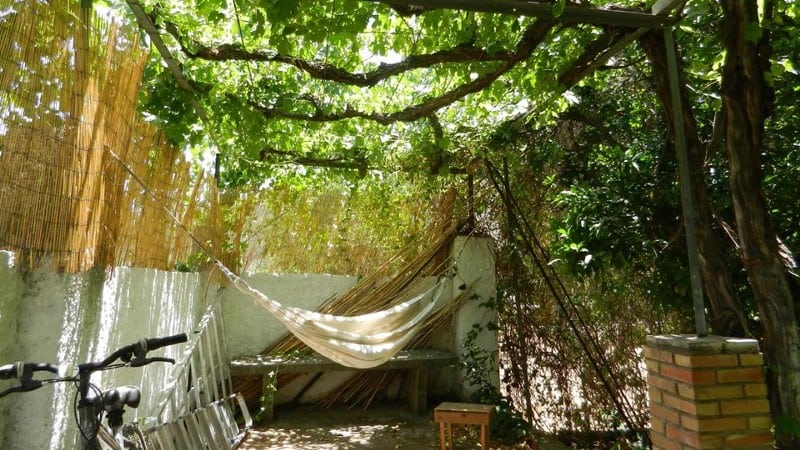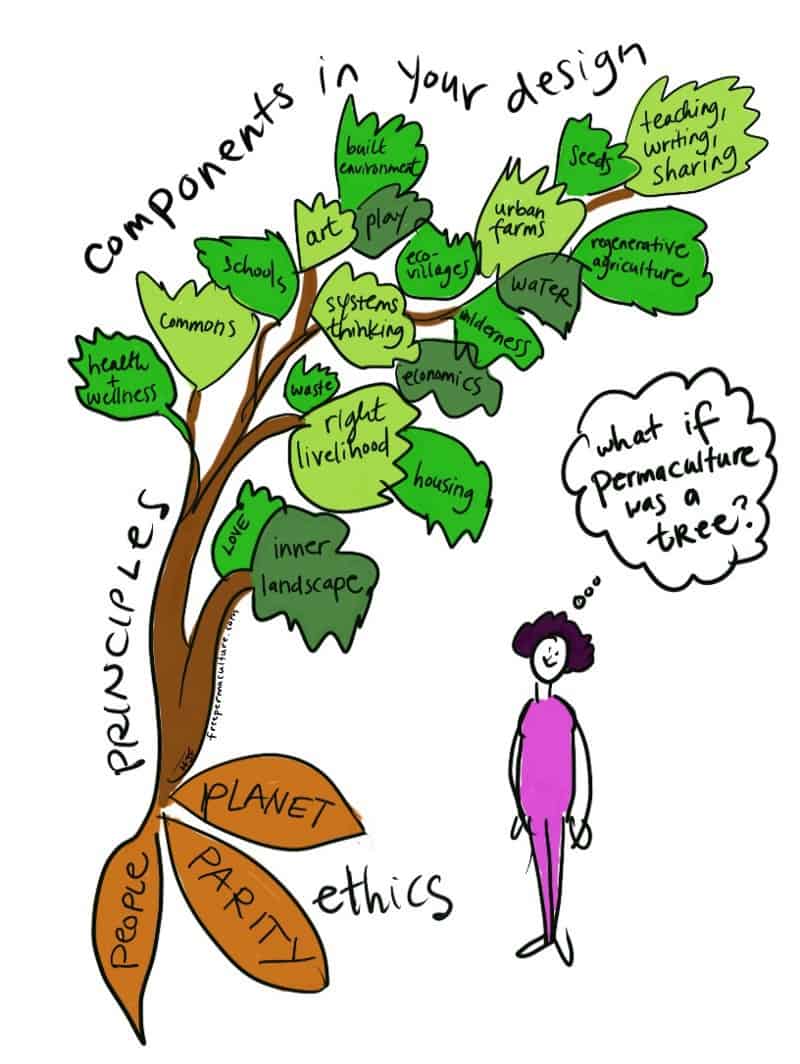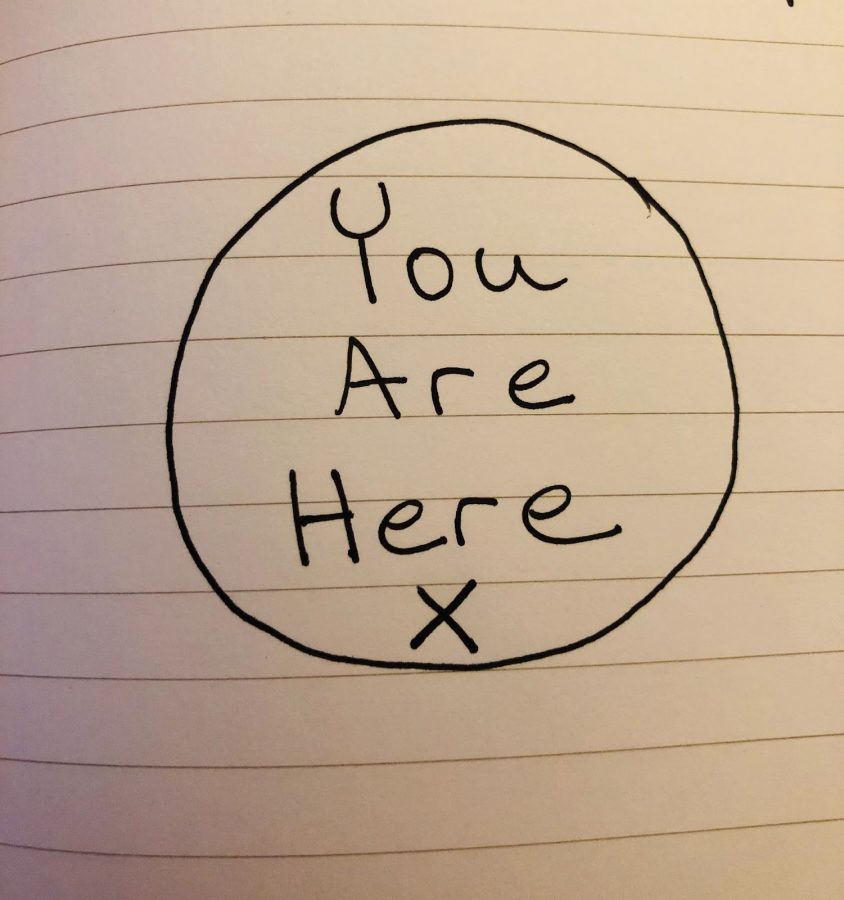
“Contact with the soil reminds us that we are an integral part of nature, rather than feeling shut out and excluded. The simple acts of growing and eating our own food, recreating habitats in which nature’s diversity thrives, and taking steps to live more simply are practical ways of living which connect us to an awareness of Nature’s seamless whole. Permaculture is a spiritual reconnection as well as an ecological strategy.” — Maddy Harland.

What is permaculture?
Strictly speaking, “Permaculture” is a combination of the words “permanent” and “agriculture,” spliced together, and used to describe a methodology for “the conscious design and maintenance of agriculturally productive ecosystems which have the diversity, stability, and resilience of natural ecosystems.”
Permaculture designers work to establish homesteads and communities that provide for their own needs, require minimal care, and produce and distribute surplus food and goods. Permaculture emphasizes observation, careful planning, sharing of resources, and working with nature, rather than against it. Meeting our own needs without exploiting others is the secondary goal; regenerating the Earth so that it can continue to sustain life is the first.
The permaculture design system, which contains the specific set of ethics, principles, tools and techniques, offers an opportunity for individuals, families, and communities to create a living human culture that nourishes, rather than annihilates, the Earth.
Furthermore, the same principles that make permaculture so successful on the landscape also work for designing invisible structures like social, emotional, economical, and political systems that can support your work on the ground. That’s because permaculture is not just about the elements of a system; it is also about the flows and connections among those elements. You can have solar power, an organic garden, an electric car, and a straw-bale house and still not live in a permaculture. A project becomes a permaculture only when special attention is paid to the relationships between each element, among the functions of those elements, and among the people who work within the system.
Through a permaculture design process, we can organize these relationships for optimum success. Our creativity is our most powerful tool for overcoming the ills of our culture, and design helps us harness that creativity and put it to work.

Yet, while the word permaculture does refer to a specific toolshed and philosophy, most of what permaculture teaches is not new information. Many of these techniques come from indigenous practices around the world, and some of them feel so natural that you can easily intuit your way through them, once you get started.
So where do you start?
In permaculture, it begins with what Mollison called the prime directive: to take responsibility for the needs of ourselves and our children. And, in pursuit of that directive…we begin with ethics.
Permaculture stems from a triad of ecological ethics: First, care for the earth, because the earth sustains our lives. Second, care for the people, because we need to look after ourselves and each other, and because people are the primary cause of damage to the earth.
And that brings us to the third ethic.
That pesky third ethic!
In his monumental Permaculture: A Designer’s Manual (1988) Bill Mollison taught the third ethic as “limits to population and consumption.” Rosemary Morrow used “redistribute surplus to one’s needs” in Earth Users Guide to Permaculture. In Gaia’s Garden (2001) Toby Hemenway used “return the surplus.” I used “recycle all resources towards the first two ethics“ in my book, Food Not Lawns, How to Turn Your Yard into a Garden and Your Neighborhood into a Community (2006.) Jessi Bloom used “careful process” in her book Practical Permaculture (2016.) In David Holmgren’s, the third ethic is distilled into the bland and unoffensive “fair shares,” whatever that means.
Nobody seems to agree, and you’ll encounter these ethical variations again and again on your permaculture journey, but the point that isn’t often made is that a thorough, multi-level understanding of what permaculture is and does can be found within the ongoing, sometimes controversial discussion about the third ethic.
The problem is the solution, as it were.
So, in the interest of deepening our understanding, let’s unpack a few different versions:
Limits to population and consumption.
Clear, specific, and controversial, this original version of the third ethic is a call to action that can trigger a lot of negative response. Without veering off into a treatise on the permaculture community’s aversion to discussing overpopulation, let’s just say that this version is probably the least popular in many permaculture circles today.
Return the surplus.
This version of the third ethic reminds us that unused resources equal waste and therefore pollution, and we can increase cyclic opportunities by sending it all back around. This makes lots of sense, in some ways, but can be problematic because it’s too easy to assume something is a “surplus” when in fact somebody else might be already using it, or in desperate need of it. If we remove ourselves from the center of the design, and consider the needs of other species, the notion of “surplus” becomes confusing.

Fair share.
Sure. Ok. But who decides what’s fair? Lots of room for misinterpretation here. Lots of corners to cut. But this version is, for me, too much watered down, too easy to ignore, and I have seen too many privileged permaculture property owners yammering on about “fair shares” while exploiting volunteer workers and enjoying the first-world luxuries of the 1%.
Recycle all resources towards the first two ethics.
I’ve always been a pragmatist, and in Food Not Lawns I wrote, ”Recycle all resources toward the first two ethics, because surplus means pollution and renewal means survival.” I still very much appreciate and agree with this perspective, because it feels tangible, measurable. But I also feel that this version lacks precision. It lacks specificity. Recycle which resources? And how, exactly? The first two ethics? So, we recycle everything towards caring for the Earth and caring for the people? Sure, ok. But again, it feels kind of watered down. This version doesn’t do enough to say: “Hey! Step up! This is on you!”
Careful process.
This version asks us to consider the impacts of our actions, and to become aware of how our pursuit of happiness and “sustainability” could have negative effects on others. If we look at how humans have provided for ourselves throughout history, we see a trail of tears, carnage, and denial, all of which might have been avoided if approached with a more careful process. I find this version provocative and empowering but also lacking in accountability. To me, it feels like it could be too easy to say “I was careful, so it’s not my fault.” Because being careful isn’t enough. We have to be vigilant, and we have to be proactive, aggressive in our pursuit of balance.
Future Care.
Originated in the African Permaculture school and used by Starhawk, Maddy Harland, and other well-known feminist teachers, this version echoes the “seven generations” consideration of many Indigenous and ancient traditions, and asks us to work for those who will live after we are gone. It asks us to embrace our role as “determiners” of the future, and to take responsibility for the future we’re creating with every action we take today. Yes, of course, and always. But this version takes us out of the present, and, to me, feels hyper-spiritual, almost evangelical. I don’t know about you, but I have a hard time concentrating on something that will happen when I’m dead.
So, where’s the common ground in all of these?
On one hand, we could just say “let’s use all of the above,” because every one of these versions has merit, and every version has flaws. But let’s look for common ground. The third ethic, by any name, always has two sides:
The first is about boundaries, limits, and self-regulation.
The second side is the sharing of resources.
But why is the combination of these two actions so crucially central to permaculture that it shares the ethical throne alongside Care for the Earth and Care for the People?
Lately I’ve been working with an ethical triad that looks like this:

Parity
Parity is an old word with many meanings. It comes from the latin parere, which means “to bring forth.” In the 1700’s it meant “equality of rank or status,” as applied to the society that was unfolding during “the enlightenment.” In the 1950’s it was used to describe a “condition in which adversaries have equal resources,” and in the 1970’s it was often used to describe what women fighting for equal pay were trying to get.
These days, parity is generally defined as meaning equality, balance, and fairness.
At first glance, my ethical triad of People-Planets-Parity seems a play on the “triple bottom line” of the oxymoronic “sustainable development” movement: “People-Planet-Profit,” which is, I assume, what they chant to make themselves feel better about capitalist exploitation.
And, while I wasn’t thinking of the so-called green capitalists when I made my triad, I appreciate the connection, because, while I do see the value in obtaining a yield, the third ethic is all about asking ourselves who we are taking that yield from.
Think about that for minute. Think about it for an hour.
No, really. Go for a walk and think about what care, equality, and fairness really mean to you. Is your life more important than a flea? Why? More important than a bear? How about your neighbor’s life? Is yours more important than theirs? Why? Or why not?
Let’s talk about equity too. It’s not the same as equality.
So, does the short person get the taller chair so they can see the show as well as the tall person? Why? Or should the short person be required to bring their own chair, and the tall person required to stand at the back? Why?
How far does it all go, and who decides? And who has the authority to enforce these ethical laws?
On our quest for balance, wholeness, and sustainability, we have to be careful about trying to make everyone obey and conform. It doesn’t work that way. It’s complicated, and there is no one true path. But that doesn’t give us an excuse to stop trying.
Mutual Aid
All of this preamble could easily be summarized under one term that has been around longer than the word “permaculture”: Mutual Aid.
As described by Peter Kropotkin in his seminal work “Mutual Aid: A Factor of Evolution,” mutual aid refers to the cooperation and reciprocal assistance among individuals and groups, especially in the natural world.
Mutual aid goes beyond charity or simple exchange; it’s about a deeply interconnected system where individuals and communities work together for the benefit of all. It’s a system of give and take that ensures survival and flourishing, not just for one, but for everyone involved.
In permaculture, mutual aid manifests in the practices of sharing resources, knowledge, and responsibilities. It’s about cultivating a culture where neighbors help neighbors, where surplus food is distributed to those in need, and where the health of the land is a shared responsibility. This model fosters a more resilient, interconnected community that aligns with the core ethics of permaculture.
Equality, equity, and the elephant in the room.
Sadly, it is precisely our failure to acknowledge the third ethic that so often divides the permaculture community. And the defiant refusal to address social justice, mental health, and decolonization, as part of a whole system design platform, characterizes a large and domineering faction of the movement.
Add to that the sad but plain fact that no small number of well-known permaculture teachers face multiple accusations of abuse, fraud, exploitation, copyright infringement (people have simply copy-pasted my work, cropped off my name, and used it as their own, many many times) and sexual harassment, and what we have left is a global community of highly-skilled designers doing some good work but being oft-overshadowed by a massive berm of seemingly unresolvable ethical differences that could threaten to discredit our movement as a whole.
#permaculturemetoo?
Yeah, it’s a thing. And I’m hardly the whistle-blower on this. We’ve all been riding the elephant in the room for decades now.
Fact: an ecological design cannot be implemented unless its inhabitants are willing to engage, collaborate, compromise, and actively participate in the ongoing evolution of it.
I started the Permaculture Women’s Guild (PWG) in direct defiance of the long-discussed, yet for the most part largely-enabled patriarchal power structure that continues to exist in the global permaculture community. And my goal with PWG is to achieve, well, parity.
By any name, the 3rd Ethic is care, in action.
By any name, the 3rd Ethic is an overt effort to strike a balance, whether it’s equal pay, shared resources, giving credit where it’s due, or initiating a return of what was taken.
By any name, the 3rd Ethic is on the books, clear, defined, measurable. It is concrete. You can see it, document the effects of it, and replicate the process as needed.
As of this writing, the long-term working models of thriving, sustainable ecological design are few and far between, with many of the very-close-to-it examples hiding those dirty abuse secrets under the tattered blue tarps and piles of hoarded resources (read: undistributed surplus/waste/imbalance/disregard for the third ethic.)
How do you define the permaculture third ethic?
Do you simply repeat that which you were taught, or do you engage in a daily praxis with an ethical foundation that you have rigorously and passionately investigated?
Because, if we can master the third ethic, then it can unlock the doors to the first two.
If we can tighten our design, strike a better balance in our emotional and social landscapes, and spiral back out to extend that balance, that awareness, that parity to the other humans and resources we’re working with, then perhaps we can, as a movement, birth a chance at survival as a species.

Except…there’s another elephant in the room.
Remember when I said parity is sometimes defined as “equality of rank or status”?
So, using parity in a permaculture context would imply that no species ranks higher than the rest.
Full stop.
What if we were to make the radical shift, in our consciousness as individuals, as a movement, and as a species, towards balancing the hierarchy of species on the planet, and pull ourselves, intentionally, from the top? How would that change the future?
Is it possible that letting go of our attachment to permanence, and accepting our inevitable extinction as a species, is actually the most ecological thing we can do?
Would an “all-species permaculture,” in the interest of working with nature, rather than against her, entertain the notion that human extinction might actually be part of a sustainable whole-system design?
Because, let’s face it:
Permanence goes against nature.
If we are truly going to embrace that pesky third ethic, that means we need to question the word “permaculture,” and question the assumption that we as a species are entitled to permanence on this earth. My purpose here is not to alienate anyone, but to integrate a broader and perhaps more inclusive perspective into the mind-shed we’re building and the global community it serves.
Extinction is natural. Yes, it has accelerated, at least during the timeline our puny human brains can comprehend. And universal law shows us that, once the cycle between order and chaos has tipped too far in one direction, it cannot be stopped until it pushes all the way back through again. If a rock is already rolling downhill and it’s heavier than you, you can’t stop the rock.
Can permaculture try to stop the rock? Should permaculture try to stop the rock? Or does that go against nature?
The scope and quality of our survival is largely dependent upon how we deal with the inevitable and sometimes horrible facets of humanity.
So, what’s our design strategy?
(Spoiler alert: I don’t know the answers.)
Be Here Now
All cataclysmic inevitabilities aside, permaculture, in practice, whether agricultural, structural, social, emotional, or any combination of the above, is simply loads of fun. A permaculture life, on any scale, is filled with wonder and abundance!
There is truly no place I would rather be than out in the yard, moving stuff around and trying to figure out how to connect elements together to make my home and garden more beautiful, more productive, less consumptive, less wasteful. When I take action toward caring for the earth, and toward designing my life in concert with my ecological community, it feels really good.

When you train your mind to remember permaculture theories, to pull them out like a master craftsperson would pull out her favorite chisel, then you begin to see everything around you in a different way. By putting our hands in the soil, we gain access to the wisdom of the earth, and by putting our heads together we learn how to use that knowledge for the benefit of all.
These slow, steady changes in the way you experience the world shouldn’t be taken lightly, nor should they be rushed. And, just reading this article won’t get you much farther than the armchair — you have to get out there and try this stuff in your own yard, in your own community.
You have to do the thing. Daily.
However, in closing, I feel the need to caution against allowing “permaculture” or any other catchphrase to replace critical thought, common sense, and a steadfast commitment to being present, available, vulnerable, and willing to do the work, on the ground, on the daily. And not just the land-work. The heart-work is just as important. That’s what the third ethic is about. That’s what permaculture is. And that’s why we’re all here, together, today.
My own work stems from an autonomous, egalitarian approach that includes permaculture but also includes a wide range of other beliefs, philosophies, tools, and techniques, I believe that in this type of flexible, individualized approach lies our true power as a global movement.
Each of us has only herself to be, to blame, and to rely upon, and our own behavior is at the root of any social or environmental change. If we want peace, we have to be peaceful. If we want to live in paradise, we have to grow it.
Because flowers aren’t the only things that bloom in the garden — people do too!
And, when people participate in an ecological design, when we work hard to improve soil, purify water, plant trees, encourage wildlife, reduce pollution and waste…something deep inside of us shifts. We tune in to the subtle voices of nature. We become more aware of our bodies, more mindful of our impact on the environment, better at listening and communicating, and more able to overcome fears and obstacles.
So, let us engage as a community of individuals who think our own thoughts, do our own work, and yet trust and rely upon each other as we move toward a common and fruitful future. One step at a time, we can become adept at caring for the Earth, caring for the people, and finding a myriad of ways to communicate and demonstrate equality, sharing, and abundance.
Like yoga, like writing, like art, permaculture is a life-path, a daily practice. And, at first, you might not feel like you’re very flexible. Don’t worry about it. Just keep trying. Breathe in, breathe out, chop wood, carry water.




